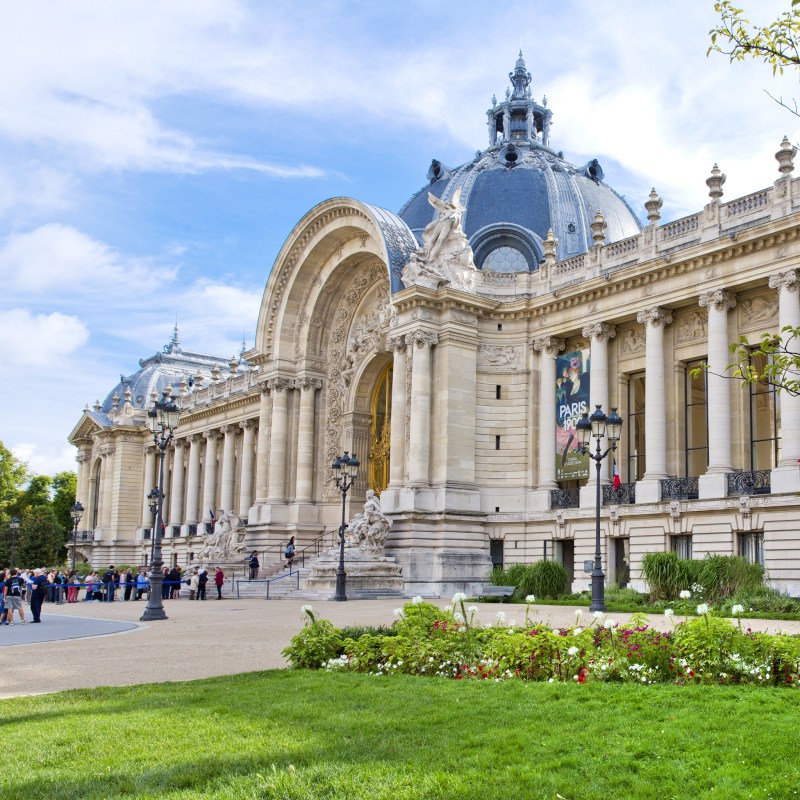
If you are traveling to Paris on a budget, costs for tickets to see the most important monuments can add up quickly. Currently, tickets for the Louvre are 17 euros ($20); the top of the Eiffel Tower, 26 euros ($31); the Catacombs, 29 euros ($34.50) with an audio guide; and the top of the Arche de Triomphe, 17 euros ($20).
Videos by TravelAwaits
The good news is that there are many Paris museums and cultural sites that are free of charge, many of which are enriching experiences that are off the beaten path. Here’s a list of eight of them, informed by my many many years living and leading tours in the City of Light.

1. Carnavalet Museum
Three stunning former palaces from the 1500s and 1600s, taking up almost an entire square block in the Marais district of Paris, have been a museum since 1880. Once the home of the most celebrated female letter writer in French history, Madame Sevigne, the Carnavalet Museum is all about the history of Paris. The Carnavalet Museum has recently gone under an extensive, four-year renovation and will be open again in early 2021.
The permanent collection, which is free to the public, encompasses various exhibits that include furniture, objects d’arts, photography, paintings, sketches and drawings, and sculptures from the Middle Ages up until the 20th century.
The Carnavalet also has a formal courtyard garden along with two other small gardens. The impressive entrance has a cobblestone courtyard with a commanding statue of King Louis XIV in the center. A restaurant and tearoom has been included in the renovation.

2. Pere-Lachaise
Believe it or not, one of the top 10 attractions in Paris is the Pere-Lachaise cemetery. A single tombstone has elevated the cemetery to its present popularity, the cult figure: that of Jim Morrison of the 1960s rock group The Doors. Morrison died of a drug overdose in Paris in 1971, and ever since he was buried in Pere- Lachaise, fans of many generations have made pilgrimages to the tombstone, leaving notes, poems, candles, flowers, and objects in memory.
Pere-Lachaise, the largest park and cemetery in Paris, covers an immense 110 acres, spreading out over two zones of the city and has over 1,000, 000 graves. You can spend a few hours in the serene park with lush greenery and over 5,000 trees, or you can spend days searching the wealth of the various styles of tombstones.
Other legendary people buried in Pere-Lachaise include Edith Piaf, Oscar Wilde, Sarah Bernhardt, Isadora Duncan, Gertrude Stein, Colette, Marcel Marceau, and Abelard and Heloise, who are the oldest inhabitants buried in the cemetery.
Pro Tip: Check out the comprehensive guidebook about Pere-Lachaise, City of Immortals by Carolyn Campbell, which includes three self-guided tours, a separate map, and access to a downloadable app.

3. Petit Palais
Built for the 1900 Paris World’s Fair, admiring the gorgeous, art nouveau design of the Petit Palais is an added bonus to viewing the permanent collection of artworks. Designated as the fine arts museum of Paris, the Petit Palais has two floors filled with art treasures including paintings, sculptures, ceramics, and drawings. The nine categories of art periods include the Classical World, Icons, Middle Ages, Renaissance, 17th, 18th, and 19th Centuries, and Paris 1900. Artists include Jean Baptiste Corot, Eugene Delacroix, Monet, Rodin, Ingres, Cezanne, Modigliani, and Pissarro.
The spectacular entrance made of limestone has a long stairway, side columns, and a grand archway with a tower on top.
A highlight of the museum is the garden courtyard lined with pink granite columns, mosaic tile floors, statues, a fountain, and lush greenery. There’s a reasonably priced cafe and snack bar, and you can enjoy lunch, drink, or a snack at cafe tables in the courtyard.

4. Victor Hugo Museum
Located on the oldest square in Paris, the Place des Vosges, the Victor Hugo Museum is the former townhouse of France’s most beloved writer and author. Hugo maintained his residence on Place des Vosges from 1832 to 1848, and it’s where he wrote part of Les Miserables.
The apartment is arranged chronologically into three significant periods of Hugo’s life: before exile, exile, and after exile (Hugo self-exiled himself for political reasons from 1851 to 1870 to Jersey and Guernsey, neighboring islands in the English Channel). Rooms include the antechamber with family portraits hung on the walls; the Red Lounge, lined with red damask drapes, where he spoke of the art, literature, and politics of the day with invited guests; the Chinese Lounge decorated with Chinese art panels; the formal dining room with heavy, gothic style wood furniture, the small study, which holds small, temporary exhibitions of collections of drawings, paintings, and photographs; and finally, Hugo’s bedroom, which features a standing desk where Hugo spent time writing.
After your visit through the museum, take a stroll through the Place des Vosges and browse the contemporary art galleries or have lunch or a drink at one of the many outdoor cafes on the square.

5. Lutece Arena
Did you know that Paris was originally settled by the Romans from about 75 A.D. to 150 A.D.? A classic Roman arena was built during this period but was later covered and made into a cemetery. Its exact location was unknown until the 1860s when the area was excavated to build a streetcar track and the almost intact arena was rediscovered. Today it is open to the public with a connecting park and garden. The arena originally could hold up to 15,000 spectators and was used for lion fights, chariot races, and games. Victor Hugo and a group of passionate preservationists fought to keep the arena from being demolished. There are still the remains of the bleachers for the spectators and you can sit in them and imagine chariots racing on the stage in the middle of Paris.
The Arena is located in the Latin Quarter near the Sorbonne University and the Pantheon.

6. Museum Of Romantic Life (Musee De La Vie Romantique)
The Museum of Romantic Life is a delightful visit to a home, artist’s atelier, and idyllic garden in a quiet, residential neighborhood of Paris with very few tourists.
The museum was the home of Ary Scheffer, a successful artist who painted mostly portraits in the 1800s. The entrance of the museum takes you down a long, tree-lined pathway until you get to the former studios of Scheffer on the left and right side, which now have temporary exhibitions. Next is the courtyard where the compact but luxurious home of Scheffer is located, which was built in 1830. The house was recently redecorated by a top Parisian interior designer who furnished it with authentic period pieces. The house has many of the portraits Scheffer painted and on the main floor are glass showcases displaying the jewelry collection of Scheffer’s friend, the writer George Sand.
The neighborhood where Scheffer lived attracted many artists, writers, musicians, composers, and poets, and every Friday night, he would host a salon and invite guests such as Chopin, George Sand, Charles Dickens, Franz Liszt, opera composer Rossini, and Eugene Delacroix.
The heavenly garden is a lovely spot to have a coffee or a snack from the former greenhouse, which is now a cafe.

7. Bourdelle Museum
Antoine Bourdelle was a prolific sculptor who lived in Paris from1861 to 1929. His large studio with a complex of buildings was made into a museum in 1925 when he was still alive. After Bourdelle’s death, Gabriel Cognacq donated money to preserve Bourdelle’s work and studio. The museum contains over 500 of Bourdelle’s works including bronze, plaster, and marble statues, paintings, and pastels plus Bourdelle’s private art collection with works by Rodin (who was a peer of Bourdelle), Eugene Carriere, Ingres, and Delacroix.

8. Musee Cognacq-Jay
Musee Cognacq-Jay is another small gem of a museum located in the Marais district, around the corner from the Carnavalet Museum.
The museum, housed in an exquisite, former mansion from 1570, contains the incredible collection of mostly 18th-century antiques by Theodore-Ernest Cognacq and his wife Marie-Louise Jay, who were the founders of the luxury department store chain La Samaritaine. Over a period of 25 years beginning in 1920, Cognacq and Jay amassed over 1,200 items including furniture, porcelains, jewels, paintings and artworks, decorative screens, tapestries, and rugs that you can see here.
The collection is artfully displayed in 20 dark wood-paneled rooms over four floors.
Pro Tips
All of the museums above have free entry; however, they may charge separate entry fees for temporary exhibitions.
If you are patient enough to wait in line for a few hours, almost all the major museums in Paris have free admission the first Sunday of the month, including the Picasso Museum, the d’Orsay, Pompidou Center, Cluny Museum, and the Orangerie.
Want more Paris tips? Read up on:
